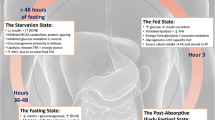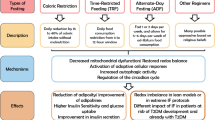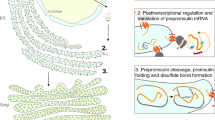Abstract
The inducible expression of the 70-kDa heat shock proteins (HSP70) is associated with homeostatically stressful situations. Stresses involving sympathetic nervous system (SNS) activation, including α1-adrenergic agonists and physical exercise, are capable of inducing HSP70 expression and release of the HSP70 inducible form, HSP72. However, whether hypoglycaemia is capable of influencing HSP70 status under a stressful situation such as insulin-induced hypoglycaemia (IIH), which also involves SNS activation, is unsettled. Hence, we decided to investigate whether the predominant signal for HSP70 expression and delivery into the blood comes from either low glucose, high insulin, or both during short-term IIH (STIIH) and long-term IIH (LTIIH). Our data indicated that low glucose level (up to 1.56 ± 0.14 mM), but not insulin, is the triggering factor responsible for a dramatic rise in HSP72 plasma concentrations (from 0.15 ± 0.01 in fed state to 0.77 ± 0.13 ng/mL during hypoglycaemic episodes). This was observed in parallel with up to 7-fold increases in interleukin-6 (IL–6) but not interleukin-10 (IL–10) or tumour necrosis factor-α (TNF–α) at STIIH. Together, the observations may suggest that HSP72 is released under hypoglycaemic conditions as a part of the homeostatic stress response, whereas at long-term, both hypoglycaemia and insulin may influence HSP72 expression in the liver, but not in kidneys. Secreted extracellular HSP72 (eHSP72) may be purely a danger signal to all the tissues of the body for the enhancement of immune and metabolic surveillance state or actively participates in glycaemic control under stressful situations.




Similar content being viewed by others
Abbreviations
- HSP70:
-
The 70 kDa family of heat shock proteins
- IIH:
-
Insulin-induced hypoglycaemia
- IL-6:
-
Interleukin-6
- IL-10:
-
Interleukin-10
- TNF–α:
-
Tumour necrosis factor alpha
- STIIH:
-
Short-term IIH
- LTIIH:
-
Long-term IIH
- SNS:
-
Sympathetic nervous system
References
Boorstein WR, Ziegelhoffer T, Craig EA (1994) Molecular evolution of the HSP70 multigene family. J Mol Evol 38:1–17
Krenek S, Schlegel M, Berendonk TU (2013) Convergent evolution of heat-inducibility during subfunctionalization of the Hsp70 gene family. BMC Evol Biol 13:49. doi:10.1186/1471-2148-13-49
Ritossa F (1962) A new puffing pattern induced by temperature shock and DNP in Drosophila. Experientia 18:571–573
Hageman J, van Waarde MA, Zylicz A, Walerych D, Kampinga HH (2011) The diverse members of the mammalian HSP70 machine show distinct chaperone-like activities. Biochem J 435:127–142. doi:10.1042/BJ20101247
Kampinga HH, Hageman J, Vos MJ, Kubota H, Tanguay RM, Bruford EA, Cheetham ME, Chen B, Hightower LE (2009) Guidelines for the nomenclature of the human heat shock proteins. Cell Stress Chaperones 14:105–111. doi:10.1007/s12192-008-0068-7
Newsholme P, de Bittencourt PI Jr (2014) The fat cell senescence hypothesis: a mechanism responsible for abrogating the resolution of inflammation in chronic disease. Curr Opin Clin Nutr Metab Care 17:295–305. doi:10.1097/MCO.0000000000000077
Krause M, Rodrigues-Krause J, O’Hagan C, Medlow P, Davison G, Susta D, Boreham C, Newsholme P, O’Donnell M, Murphy C, De Vito G (2014) The effects of aerobic exercise training at two different intensities in obesity and type 2 diabetes: implications for oxidative stress, low-grade inflammation and nitric oxide production. Eur J Appl Physiol 114:251–260. doi:10.1007/s00421-013-2769-6
Hooper PL, Balogh G, Rivas E, Kavanagh K, Vigh L (2014) The importance of the cellular stress response in the pathogenesis and treatment of type 2 diabetes. Cell Stress Chaperones 19:447–464. doi:10.1007/s12192-014-0493-8
Rodrigues-Krause J, Krause M, O’Hagan C, De Vito G, Boreham C, Murphy C, Newsholme P, Colleran G (2012) Divergence of intracellular and extracellular HSP72 in type 2 diabetes: does fat matter? Cell Stress Chaperones 17:293–302. doi:10.1007/s12192-011-0319-x
Krause M, Keane K, Rodrigues-Krause J, Crognale D, Egan B, De Vito G, Murphy C, Newsholme P (2014) Elevated levels of extracellular heat-shock protein 72 (eHSP72) are positively correlated with insulin resistance in vivo and cause pancreatic beta-cell dysfunction and death in vitro. Clin Sci (Lond) 126:739–752. doi:10.1042/CS20130678
Ogawa K, Kim HK, Shimizu T, Abe S, Shiga Y, Calderwood SK (2012) Plasma heat shock protein 72 as a biomarker of sarcopenia in elderly people. Cell Stress Chaperones 17:349–359. doi:10.1007/s12192-011-0310-6
De Maio A, Vazquez D (2013) Extracellular heat shock proteins: a new location, a new function. Shock 40:239–246. doi:10.1097/SHK.0b013e3182a185ab
Heck TG, Scholer CM, de Bittencourt PI (2011) HSP70 expression: does it a novel fatigue signalling factor from immune system to the brain? Cell Biochem Funct 29:215–226. doi:10.1002/cbf.1739
Chin JH, Okazaki M, Hu ZW, Miller JW, Hoffman BB (1996) Activation of heat shock protein (hsp) 70 and proto-oncogene expression by alpha1 adrenergic agonist in rat aorta with age. J Clin Invest 97:2316–2323. doi:10.1172/JCI118674
Giraldo E, Multhoff G, Ortega E (2010) Noradrenaline increases the expression and release of Hsp72 by human neutrophils. Brain Behav Immun 24:672–677. doi:10.1016/j.bbi.2010.02.003
Lacoste A, Malham SK, Cueff A, Poulet SA (2001) Noradrenaline modulates oyster hemocyte phagocytosis via a beta-adrenergic receptor-cAMP signaling pathway. Gen Comp Endocrinol 122:252–259. doi:10.1006/gcen.2001.7643
Johnson JD, Campisi J, Sharkey CM, Kennedy SL, Nickerson M, Fleshner M (2005) Adrenergic receptors mediate stress-induced elevations in extracellular Hsp72. J Appl Physiol 99:1789–1795. doi:10.1152/japplphysiol.00390.2005
Liu Y, Gampert L, Nething K, Steinacker JM (2006) Response and function of skeletal muscle heat shock protein 70. Front Biosci 11:2802–2827
Walsh RC, Koukoulas I, Garnham A, Moseley PL, Hargreaves M, Febbraio MA (2001) Exercise increases serum Hsp72 in humans. Cell Stress Chaperones 6:386–393
Febbraio MA, Ott P, Nielsen HB, Steensberg A, Keller C, Krustrup P, Secher NH, Pedersen BK (2002) Exercise induces hepatosplanchnic release of heat shock protein 72 in humans. J Physiol 544:957–962
Febbraio MA, Mesa JL, Chung J, Steensberg A, Keller C, Nielsen HB, Krustrup P, Ott P, Secher NH, Pedersen BK (2004) Glucose ingestion attenuates the exercise-induced increase in circulating heat shock protein 72 and heat shock protein 60 in humans. Cell Stress Chaperones 9:390–396
Bergstedt K, Hu BR, Wieloch T (1993) Initiation of protein synthesis and heat-shock protein-72 expression in the rat brain following severe insulin-induced hypoglycemia. Acta Neuropathol 86:145–153
Souza HM, Hell NS, Lopes G, Bazotte RB (1996) Synergistic effect of counterregulatory hormones during insulin-induced hypoglycemia in rats: participation of lipolysis and gluconeogenesis to hyperglycemia. Zhongguo Yao Li Xue Bao 17:455–459
Ting LP, Tu CL, Chou CK (1989) Insulin-induced expression of human heat-shock protein gene hsp70. J Biol Chem 264:3404–3408
Carey AL, Steinberg GR, Macaulay SL, Thomas WG, Holmes AG, Ramm G, Prelovsek O, Hohnen-Behrens C, Watt MJ, James DE, Kemp BE, Pedersen BK, Febbraio MA (2006) Interleukin-6 increases insulin-stimulated glucose disposal in humans and glucose uptake and fatty acid oxidation in vitro via AMP-activated protein kinase. Diabetes 55:2688–2697. doi:10.2337/db05-1404
Barrena HC, Gazola VA, Furlan MM, Garcia RF, de Souza HM, Bazotte RB (2009) Ketogenesis evaluation in perfused liver of diabetic rats submitted to short-term insulin-induced hypoglycemia. Cell Biochem Funct 27:383–387. doi:10.1002/cbf.1586
Rodrigues R, Feitosa KP, Felisberto-Junior AM, Barrena HC, Curi R, Bazotte RB (2011) Comparative effects of short-term and long-term insulin-induced hypoglycemia on glucose production in the perfused livers of weaned rats. Pharmacol Rep 63:1252–1257
Carrara MA, Batista MR, Saruhashi TR, Felisberto AM Jr, Guilhermetti M, Bazotte RB (2012) Coexistence of insulin resistance and increased glucose tolerance in pregnant rats: a physiological mechanism for glucose maintenance. Life Sci 90:831–837. doi:10.1016/j.lfs.2012.03.037
Brown ET, Umino Y, Loi T, Solessio E, Barlow R (2005) Anesthesia can cause sustained hyperglycemia in C57/BL6J mice. Vis Neurosci 22:615–618. doi:10.1017/S0952523805225105
Saha JK, Xia J, Grondin JM, Engle SK, Jakubowski JA (2005) Acute hyperglycemia induced by ketamine/xylazine anesthesia in rats: mechanisms and implications for preclinical models. Exp Biol Med (Maywood) 230:777–784
Chang Y, Chen TL, Sheu JR, Chen RM (2005) Suppressive effects of ketamine on macrophage functions. Toxicol Appl Pharmacol 204:27–35. doi:10.1016/j.taap.2004.08.011
Scheller J, Chalaris A, Schmidt-Arras D, Rose-John S (2011) The pro- and anti-inflammatory properties of the cytokine interleukin-6. Biochim Biophys Acta 1813:878–888. doi:10.1016/j.bbamcr.2011.01.034
Ye J, Zhu R, He X, Feng Y, Yang L, Zhu X, Deng Q, Wu T, Zhang X (2014) Association of plasma IL-6 and Hsp70 with HRV at different levels of PAHs metabolites. PLoS One 9:e92964. doi:10.1371/journal.pone.0092964
Kolberg A, Rosa TG, Puhl MT, Scola G, da Rocha Janner D, Maslinkiewicz A, Lagranha DJ, Heck TG, Curi R, de Bittencourt PI Jr (2006) Low expression of MRP1/GS-X pump ATPase in lymphocytes of Walker 256 tumour-bearing rats is associated with cyclopentenone prostaglandin accumulation and cancer immunodeficiency. Cell Biochem Funct 24:23–39. doi:10.1002/cbf.1290
Krause MS, McClenaghan NH, Flatt PR, de Bittencourt PI, Murphy C, Newsholme P (2011) l-arginine is essential for pancreatic beta-cell functional integrity, metabolism and defense from inflammatory challenge. J Endocrinol 211:87–97. doi:10.1530/JOE-11-0236
Bradford MM (1976) A rapid and sensitive method for the quantitation of microgram quantities of protein utilizing the principle of protein-dye binding. Anal Biochem 72:248–254
Hightower LE, Guidon PT Jr (1989) Selective release from cultured mammalian cells of heat-shock (stress) proteins that resemble glia-axon transfer proteins. J Cell Physiol 138:257–266. doi:10.1002/jcp.1041380206
Lancaster GI, Febbraio MA (2005) Exosome-dependent trafficking of HSP70: a novel secretory pathway for cellular stress proteins. J Biol Chem 280:23349–23355. doi:10.1074/jbc.M502017200
Keller S, Sanderson MP, Stoeck A, Altevogt P (2006) Exosomes: from biogenesis and secretion to biological function. Immunol Lett 107:102–108. doi:10.1016/j.imlet.2006.09.005
Savina A, Furlan M, Vidal M, Colombo MI (2003) Exosome release is regulated by a calcium-dependent mechanism in K562 cells. J Biol Chem 278:20083–20090. doi:10.1074/jbc.M301642200
Sawa T, Imamura T, Haruta T, Sasaoka T, Ishiki M, Takata Y, Takada Y, Morioka H, Ishihara H, Usui I, Kobayashi M (1996) Hsp70 family molecular chaperones and mutant insulin receptor: differential binding specificities of BiP and Hsp70/Hsc70 determines accumulation or degradation of insulin receptor. Biochem Biophys Res Commun 218:449–453. doi:10.1006/bbrc.1996.0080
Shyu WC, Chen CP, Saeki K, Kubosaki A, Matusmoto Y, Onodera T, Ding DC, Chiang MF, Lee YJ, Lin SZ, Li H (2005) Hypoglycemia enhances the expression of prion protein and heat-shock protein 70 in a mouse neuroblastoma cell line. J Neurosci Res 80:887–894. doi:10.1002/jnr.20509
Gobbel GT, Chan TY, Chan PH (1995) Amelioration of hypoxic and hypoglycemic damage to cerebral endothelial cells. Effects of heat shock pretreatment. Mol Chem Neuropathol 24:107–120
Krause MS, Bittencourt A, Homem de Bittencourt PI Jr, McClenaghan NH, Flatt PR, Murphy C, Newsholme P (2012) Physiological concentrations of interleukin-6 directly promote insulin secretion, signal transduction, nitric oxide release, and redox status in a clonal pancreatic beta-cell line and mouse islets. J Endocrinol 214:301–311. doi:10.1530/JOE-12-0223
de Galan BE, Netea MG, Smits P, van der Meer JW (2003) Hypoglycaemia downregulates endotoxin-induced production of tumour necrosis factor-alpha, but does not affect IL-1beta, IL-6, or IL-10. Cytokine 22:71–76
Bach E, Nielsen RR, Vendelbo MH, Moller AB, Jessen N, Buhl M, K-Hafstrøm T, Holm L, Pedersen SB, Pilegaard H, Bienso RS, Jorgensen JO, Moller N (2013) Direct effects of TNF-alpha on local fuel metabolism and cytokine levels in the placebo-controlled, bilaterally infused human leg: increased insulin sensitivity, increased net protein breakdown, and increased IL-6 release. Diabetes 62:4023–4029. doi:10.2337/db13-0138
Dotson S, Freeman R, Failing HJ, Adler GK (2008) Hypoglycemia increases serum interleukin-6 levels in healthy men and women. Diabetes Care 31:1222–1223. doi:10.2337/dc07-2243
Febbraio MA, Steensberg A, Fischer CP, Keller C, Hiscock N, Pedersen BK (2002) IL-6 activates HSP72 gene expression in human skeletal muscle. Biochem Biophys Res Commun 296:1264–1266
Febbraio MA, Steensberg A, Keller C, Starkie RL, Nielsen HB, Krustrup P, Ott P, Secher NH, Pedersen BK (2003) Glucose ingestion attenuates interleukin-6 release from contracting skeletal muscle in humans. J Physiol 549:607–612. doi:10.1113/jphysiol.2003.042374
Moller JC, Kruttgen A, Burmester R, Weis J, Oertel WH, Shooter EM (2006) Release of interleukin-6 via the regulated secretory pathway in PC12 cells. Neurosci Lett 400:75–79. doi:10.1016/j.neulet.2006.02.018
Febbraio MA, Pedersen BK (2002) Muscle-derived interleukin-6: mechanisms for activation and possible biological roles. FASEB J 16:1335–1347. doi:10.1096/fj.01-0876rev
Acknowledgments
This work was partially supported by grants received from the Brazilian National Council for Scientific and Technological Development (CNPq): grants from MCT/CNPq, MS/DECIT, CT-CIOTEC and CTSaúde, process #551097/2007–8, 563870/2010-9, 402626/2012-5 and 402364/2012-0, to PIHBJ and RBB; Fundação Araucária (to RBB). TGH was supported by a fellowship from Brazilian Federal Agency for the Support and Evaluation of Graduate (CAPES) while SPS and PRN were supported by fellowships from CNPq. All the authors have agreed to the submission and had final approval of the submitted and published versions.
Conflict of interest
The authors declare no conflict of interest and no competing interests such as consultancies, financial involvement, patent ownership, etc. in relation to the work described.
Author information
Authors and Affiliations
Corresponding author
Additional information
Mirna Stela Ludwig, Vânia Cibele Minguetti-Câmara and Thiago Gomes Heck equally contributed to the present work.
Rights and permissions
About this article
Cite this article
Ludwig, M.S., Minguetti-Câmara, V.C., Heck, T.G. et al. Short-term but not long-term hypoglycaemia enhances plasma levels and hepatic expression of HSP72 in insulin-treated rats: an effect associated with increased IL-6 levels but not with IL-10 or TNF–α. Mol Cell Biochem 397, 97–107 (2014). https://doi.org/10.1007/s11010-014-2176-2
Received:
Accepted:
Published:
Issue Date:
DOI: https://doi.org/10.1007/s11010-014-2176-2




